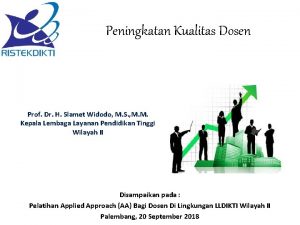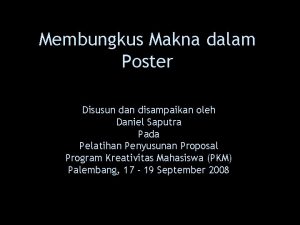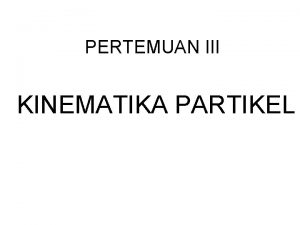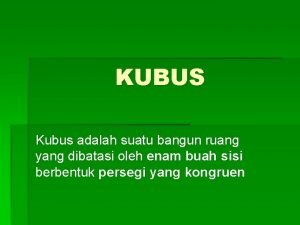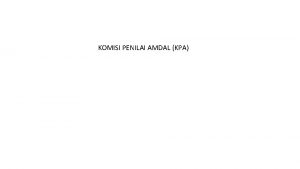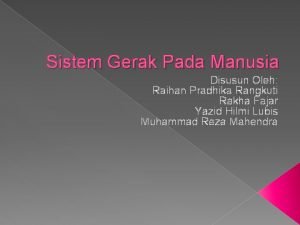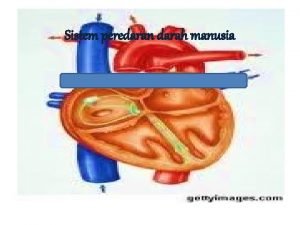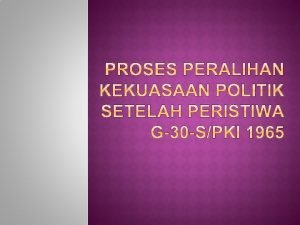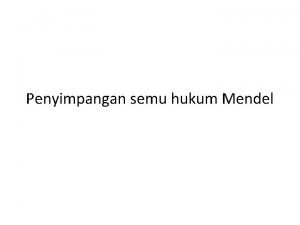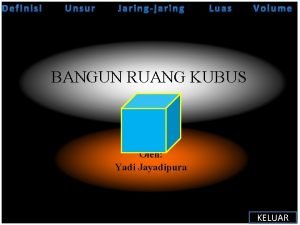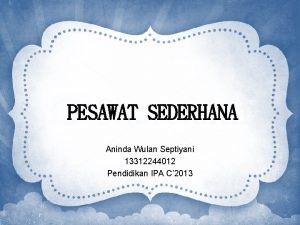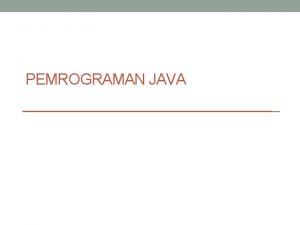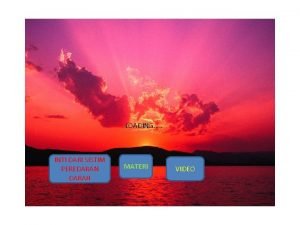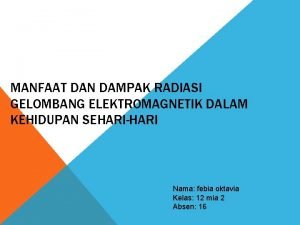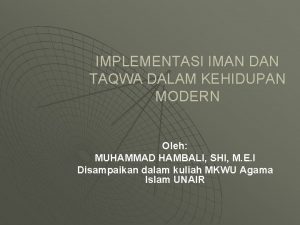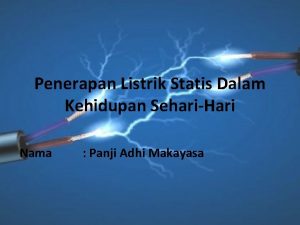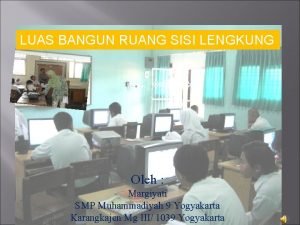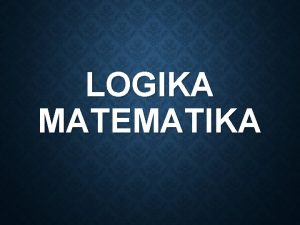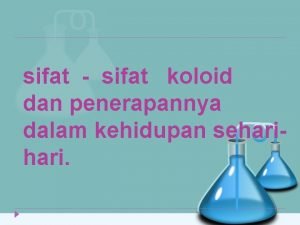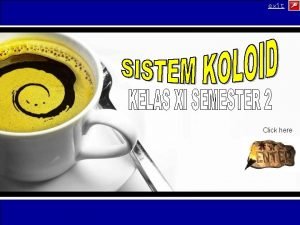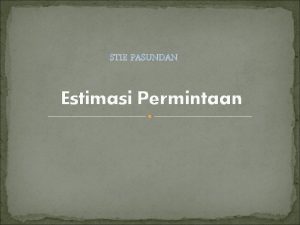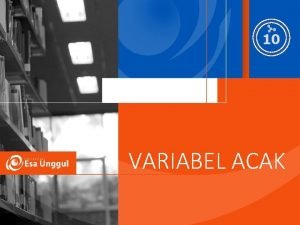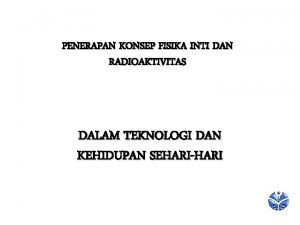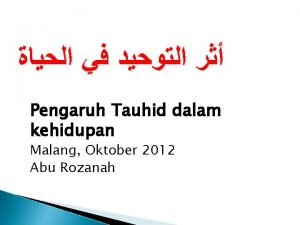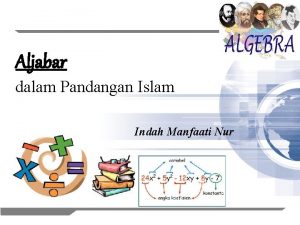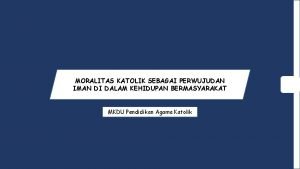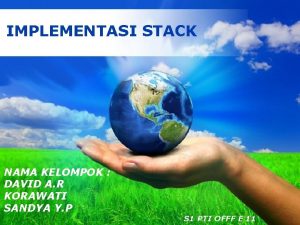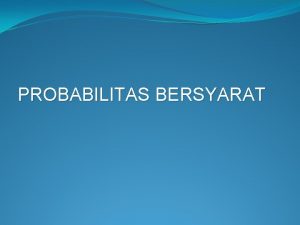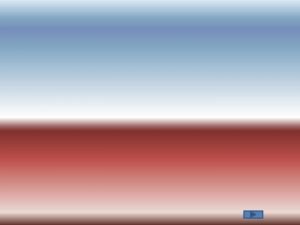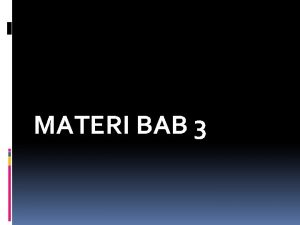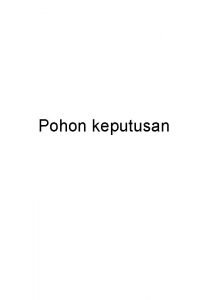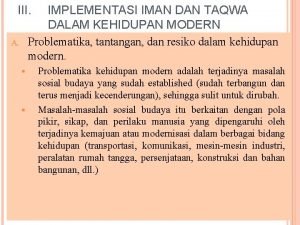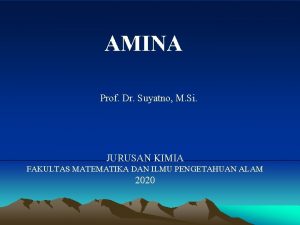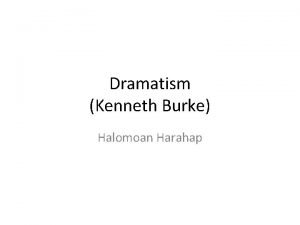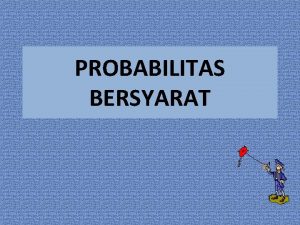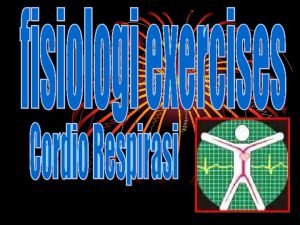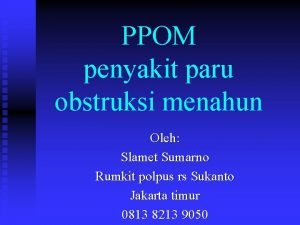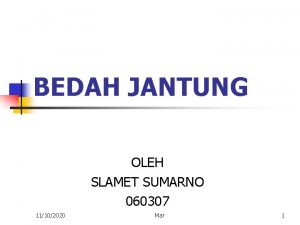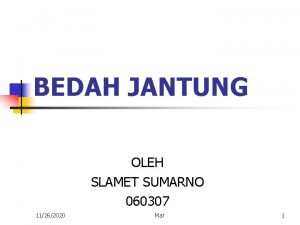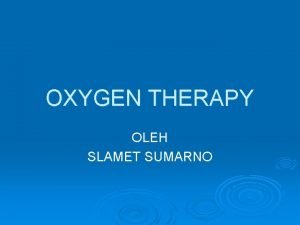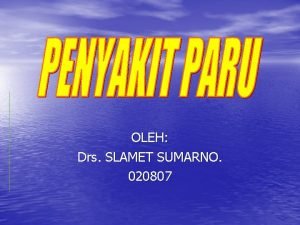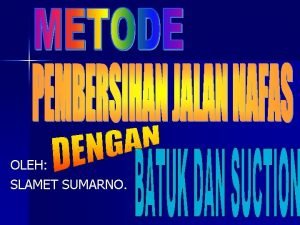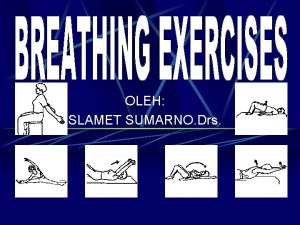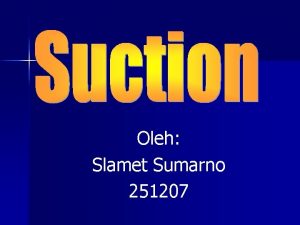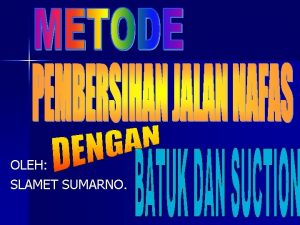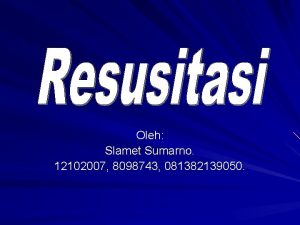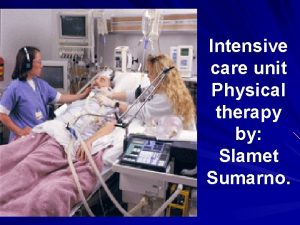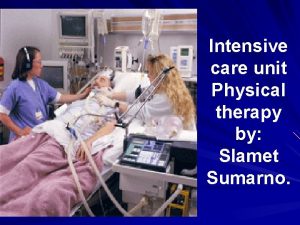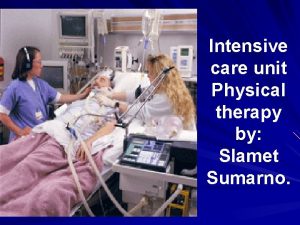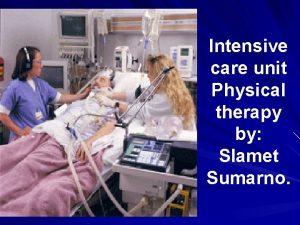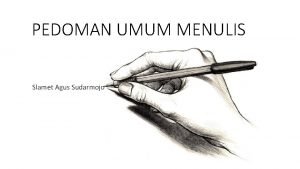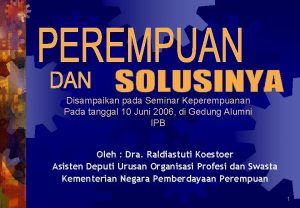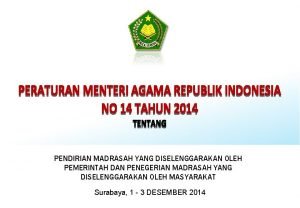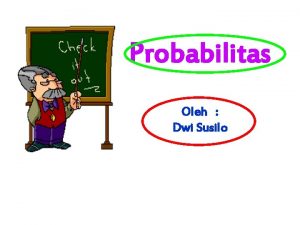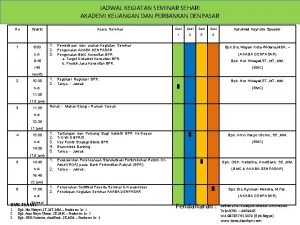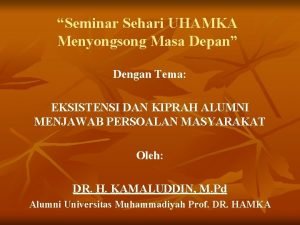OLEH SLAMET SUMARNO Disampaikan pada seminar sehari DISELENGGARAKAN
















































- Slides: 48

OLEH: SLAMET SUMARNO Disampaikan pada seminar sehari DISELENGGARAKAN : AKADEMI FISIOTERAPI UKI TGL: 15 SEPTEMBER 2007.

Kurikulum vite • Slamet Sumarno, Drs, SMPh • Wonogiri : 15 -09 -1950 • Dik. S 1 1992 Unis Syeh Yusuf Tangerang : Administrasi Negara • Akademi Fisioterapi Surakarta 1975 • Kardia Respirasi : Revalidasi Centrum Ultreh Nedherland 1983

Pekerjaan. • Fisioterapi Rumkit Polpus RS Sukanto Kramat jati Jak Tim 1976 – Sekarang. • Dosen Akfis UPN 1983 – Sekarang • Dosen Akfis Uki 1986 – Sekarang • Dosen Fakultas Fisioterapi Indonusa Esainggil 1998 • Dosen Fakultas Fisioterapi STIKES Binawan 2004 • Dosen Akbid Sukawangi 2004

Agar peserta dapat memahami: • Mekanisme pernafasan dan sirkulasi normal. • Fungsi kardiovakuler dan respirasi. • Kapasitas pernafasan dan tranportasi oksigen normal. • Mampu mengaplikasikan kordio vaskuler respirasi dalam penilaian klien/ pasien dengan baik dan benar. • Mampu menerapkan dalam gangguan kordivaskulerrespirasi khususnya dan Neuromuskular dan muskuloskeletal maupun integumen.

• We cannot live without oxygen. • Anda tidak bisa hidup tanpa oksigen • All living cells require to get oxygen from the fluid around them and to get rid of corbon dioxide to it.

1. Exchange O 2 1. Air to blood 2. Blood to cells 2. Exchange CO 2 1. Cells to blood 2. Blood to air 3. Regulate blood p. H 4. Vocalizations 5. Protect alveoli External and cellular respiration

Oksigen = 20, 93 % Carbon diaksida= 0, 03 % Nitrogen = 79, 04 % TEKANAN OKSIGEN Di Daerah SEA LEVEL

Pulmonary ventilation (breathing) is the proses by which air is moved into and out of the lungs. It has two phases: inspiration and expiration.

Proses pernafasan. 1. External Respirasi a. Inspirasi. b. Ekspirasi. 2. Internal Respirasi. a. Tranportasi (sirkulasi). b. Buffer

Inspirasi is an active process in which the diaphragm and the external intercostal muscles increase the dimensions, and thus the volume, of the thoracic cage. This decreases the pressure in the lungs and draws air in. Tekanan alveoli minus 3 s/d 10 mm. Hg < dari 760 mm. Hg.

Normal expiration is the passive process. The inspiratory muscle relax and the elastic tissue of the lungs recoils, returning the thoracic cage to its smaller, normal dimensions. This increases the presure in the lungs and forces air out.

q Forced or labored inspiration and expiration are active proceses, dependent on muscle actions. q Aktif inspirasi dibantu otot: Scalani, Sterno cledo mastoideus, pektoralis, membantu angkat sternum dan costae ke depan atas. Tekanan alveoli turun sampai 100 -80 mm. Hg. q Aktif ekspirasi dibantu otot : Abdominalis, Latisimus dorsi Inspirasi. Ekspirasi

1. Tranportasinya Exchange O 2 in cells a. Air to blood b. Blood to cells 2. Exchange CO 2 1. Cells to blood 2. Blood to air 3. Buffer

Ruang rugi anatomi dan fisiologi Ruang rugi Anatomi: Gas yanga Ada pada Jalan nafas 150 CC Ruang rugi Fisiologi: Keterbatasan Ventilasi Paru atau Raung residu Yang tinggi

DAERAH PERTUKARAN O 2 Dan CO 2: 1. Brokus respiratoris 2. Ducctus 3. Succus dan 4. Alveoli

1 Pertahanan Respiratory system Inhalasi melalui hidung Mempunyai keuntungan 1. Udara disaring. 2. Udara dilembabkan. 3. Udara dihangatkan. 4. Cegah peradangan jalan nafas bag atas.


2. Pembersih jalan nafas oleh cillia dan fungsi menelan

Perfusi eksterna Eksteranal respirasi: Dalam paru Dipengaruhi: respirasi 1. Cairan surfaktan 2. Tebal membran. 3. Volume darah 4. Hb darah 5. Kecepatan sirkulasi. 6. Vicositas darah. 7. p. H darah

Tranportasi O 2 dan CO 2 dalam darah • Kemampuan jantung (COP= HR X Stroke volume). • Tahanan perifer. • Fleksibilitas pembuluh darah. • Lumen. • Vikositas. • Hb. • Saturasi darah dll.

Ventilation: The Pumps 1. Inspiration 2. Expiration 3. Diaphragm 1. Low energy pump 2. Concavity – flattens 4. Thorax: ribs & muscles 5. Pleura: double membrane 1. Vacuum seal 2. Fluid-lubrication

Ventilation: The Pumps Pada tekanan rendah bila dua gelembung udara mempunyai tension Permukaan yg sama , Gelembung kecil mempunyai tekanan besar Surfactant reduces surface tension

Respiratory Damage & Diseases Pada tekanan rendah bila dua gelembung udara mempunyai tension Permukaan yg sama , Gelembung kecil mempunyai tekanan besar Surfactant reduces surface tension

Pengaruhi internal terhadap kemampuan tubuh suply O 2 1. Jalan nafas yang adeguat. 2. Fleksibilitan otot, fasia, kulit sangkar thorax. 3. Perfusi O 2 dan CO 2 4. Volume, Hb, Ph, Plasma darah 5. Keadan pleurae 6. Pusat kontrol fungsi pernafasan 7. Fungsi bufer.

Pengaruh eksternal terhadap kemampuan tubuh suply O 2 1. Kadar Oksigen udara. 2. Posisi tubuh 3. Usia jenis kelamin.

Factors Affecting Ventilation 1. 2. 3. 4. 5. 6. Airway Resistance Diameter Mucous blockage Bronchoconstriction Bronchodilation Alveolar compliance 1. Surfactants 2. Surface tension 7. Alveolar elasticity

1. Lung volumes , Volume paru a. RV b. ERV c. TV d. IRV 2. Capasitas paru a. Capasitas inspirasi b. Capasitas Ekspirasi c. Capasitas vital d. Capasitas total paru. e. Kapasitas residual 1200 cc 1000 500 1900 -3300 PRIA WANITA VCI 3, 3 1, 9 TV 0, 5 VCE 1, 0 0, 7 VR 1, 2 1, 1 V TOTAL 6, 0 4, 2

Clinical Cardiovascular Anatomy & Physiology Concepts, Definitions, & Principles

Jantung A. LETAK. B. UKURAN. C. LAPISAN JANTUNG. D. RONGGA. E. KATUP DAN SEKAT. F. SYARAF JANTUNG




Pumpa jantung Agar darah sampai pada sel Tubuh harus dipompa jantung Menuju jaringan, termasuk Jaringan jantung sendiri. Jumlah darah yang dipompa jantung dipengaruhi: Strooke vulume dan frekuensi Denyut jantung per menit. Makin tinggi strooke vulumee Dan frekuensi makin tingg COP Tetapi makin tinggi frekuensi Jantung makin sedikit aliran Koroner yang memberi nutresi Jantung.

Efisiensi kerja jantung. Makin kuat dan fleksibel otot Jantung , strooke volume Makin besar dan makin hemat energi kerja jantung Sehingga frekuensi jantung Permenit makin kecil. Termasuk tahanan perifer Sistem sirkulasi Tahanan perifer meliputi: 1. Vulume pembuluh darah 2. Vikositas darah 3. Trammister 4. Jenis Kerja otot.

MICRO CIRKULASI ANATOMI

Pusat kontrol cardio vaskuler respirasi

Conduction System of the Heart


Tranportasi darah dan O 2 CO 2 1. Kemampuan jantung (COP= HR X Stroke volume). 2. Tahanan perifer. 3. Fleksibilitas pembuluh darah. 4. Lumen. 5. Vikositas. 6. Hb. 7. Saturasi darah. 8. Sistem konduksi

Blood Components: Plasma Transports Solutes 1. Water, ions, trace elements 2. Gasses: O 2 & CO 2 3. Organic Molecules 1. 2. 3. 4. 5. Glucose N–wastes Proteins Antibodies Hormones

Blood Components: Plasma Transports Solutes

Blood Compon ents: "Blood Count" – % of Each Compon ent

Blood Components: Cells 1. Erythrocytes 1. Red Blood Cells (RBC) 2. O 2 & CO 2 transport 2. White Blood Cells (WBC) 1. Immune defense 2. Phagocytosis 3. Platelets: clotting

Vicositas darah

Lymphatic System: Structure and Roles (overview) 1. Lymphatic structures 1. Capillaries with valves 2. Lymph vessels 3. Lymph nodes & organs 2. Immune defense: lymphocytes 3. Transport of fats 4. Collects excess ECF 1. Returns to plasma 2. Edema

System lymphe

System Aliran Lymphe Net Out Flow Into ECF Hubungan antara kapiler dan pembuluh lymphe Aliran air dan cairan difilter keluar oleh kapiler Ke atas oleh pembuluh lymphe dan masuk sirkulasi • Net filtration – net absorption = net out flow • About 2 L/day collected by lymph vessels Figure 15 -18 b: Fluid exchange at the capillary

 Sumarno ngadiman meninggal dunia
Sumarno ngadiman meninggal dunia Prof slamet widodo
Prof slamet widodo Informasi utama disampaikan melalui
Informasi utama disampaikan melalui Pidato pada umumnya adalah
Pidato pada umumnya adalah Pesan yang disampaikan dalam poster biasanya melalui
Pesan yang disampaikan dalam poster biasanya melalui Sebutkan ciri ciri bangun ruang kubus
Sebutkan ciri ciri bangun ruang kubus Kecepatan pada geraklurusberaturandipengaruhi oleh….
Kecepatan pada geraklurusberaturandipengaruhi oleh…. Bangun kubus dibatasi oleh .... persegi yang kongruen
Bangun kubus dibatasi oleh .... persegi yang kongruen Komisi penilai amdal pusat berkedudukan di... .
Komisi penilai amdal pusat berkedudukan di... . File-file yang dibuat oleh user pada jenis file di linux
File-file yang dibuat oleh user pada jenis file di linux Sistem organ pencernaan pada manusia disusun oleh
Sistem organ pencernaan pada manusia disusun oleh Warna merah cerah pada darah manusia disebabkan oleh ….
Warna merah cerah pada darah manusia disebabkan oleh …. Javascript pertama kali diperkenalkan oleh
Javascript pertama kali diperkenalkan oleh Penggolongan kalkulator
Penggolongan kalkulator Supersemar dikeluarkan oleh presiden soekarno pada tanggal
Supersemar dikeluarkan oleh presiden soekarno pada tanggal Pada tikus warna bulu hitam dikendalikan
Pada tikus warna bulu hitam dikendalikan Sisi pada kubus dibatasi oleh
Sisi pada kubus dibatasi oleh Pengasas pengakap dunia
Pengasas pengakap dunia Keuntungan mekanik pada katrol ganda ditentukan oleh
Keuntungan mekanik pada katrol ganda ditentukan oleh Java diciptakan pada tahun 1991 oleh
Java diciptakan pada tahun 1991 oleh Sistim peredaran darah
Sistim peredaran darah Logo sejarah
Logo sejarah Manfaat gelombang elektromagnetik di kehidupan sehari-hari
Manfaat gelombang elektromagnetik di kehidupan sehari-hari Implementasi iman dan taqwa
Implementasi iman dan taqwa Penerapan listrik statis dalam kehidupan sehari-hari
Penerapan listrik statis dalam kehidupan sehari-hari Contoh bangun ruang sisi lengkung
Contoh bangun ruang sisi lengkung Dalil kesetaraan logika matematika
Dalil kesetaraan logika matematika Koloid hidrofil
Koloid hidrofil Sifat koloid
Sifat koloid Pengertian estimasi
Pengertian estimasi Contoh percobaan variabel acak diskrit
Contoh percobaan variabel acak diskrit Peta konsep fisika inti dan radioaktivitas
Peta konsep fisika inti dan radioaktivitas Tauhid rububiyah adalah
Tauhid rububiyah adalah Etika deskriptif merupakan
Etika deskriptif merupakan Penerapan aljabar boolean dalam kehidupan sehari hari
Penerapan aljabar boolean dalam kehidupan sehari hari Perwujudan iman adalah
Perwujudan iman adalah Contoh stack dalam kehidupan sehari-hari
Contoh stack dalam kehidupan sehari-hari Contoh fuzzy logic
Contoh fuzzy logic Makalah probabilitas
Makalah probabilitas Perhatikan gambar disamping tujuan dan
Perhatikan gambar disamping tujuan dan Sehari selembar benang setahun selembar kain
Sehari selembar benang setahun selembar kain Nine golden habits tenaga kesehatan
Nine golden habits tenaga kesehatan Peranan tik dalam kehidupan sehari-hari
Peranan tik dalam kehidupan sehari-hari Contoh teori thorndike dalam kehidupan sehari hari
Contoh teori thorndike dalam kehidupan sehari hari Contoh pohon keputusan dalam perusahaan
Contoh pohon keputusan dalam perusahaan Implementasi iman dan taqwa dalam kehidupan modern
Implementasi iman dan taqwa dalam kehidupan modern Contoh amina dalam kehidupan sehari-hari
Contoh amina dalam kehidupan sehari-hari Dramatisme adalah
Dramatisme adalah Contoh peluang bersyarat dalam kehidupan sehari-hari
Contoh peluang bersyarat dalam kehidupan sehari-hari

